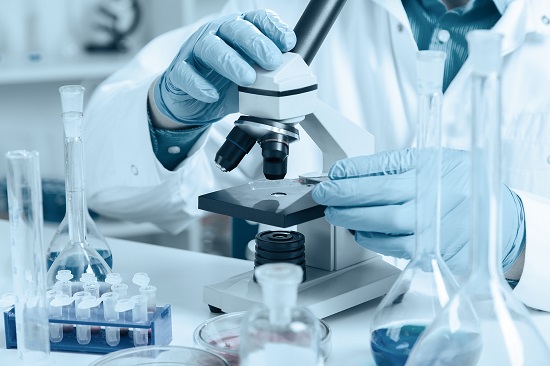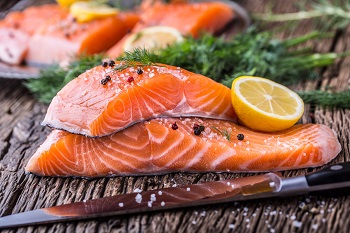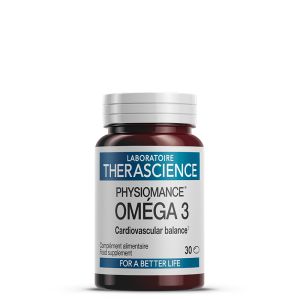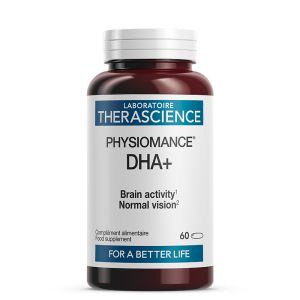
Indispensable fatty acids ? Essential fatty acids ?
Vitamins, minerals, and fatty acids

There is often confusion between the two terms. A fatty acid is essential because of its own biochemical qualities. It is in fact absolutely necessary for normal growth and the physiological functions of the body. A fatty acid is indispensable when it cannot be synthesised by the body; it must be provided by the diet. Essential fatty acids are the two precursors of each of the two families: alpha-linolenic acid for omega-3 and linoleic acid for omega-6.
Omega-3
The omega-3 series comprises three molecules. Precursor and leader of this family: alpha-linolenic acid (ALA), rated 18: 3 n-3. Its elongation followed by desaturation (via delta-5 desaturase) leads to eicosapentaenoic acid (EPA). Three other reactions, elongation, desaturation (via delta-6 desaturase) and beta-oxidation, lead from EPA to docosahexaenoic acid (DHA). Plants - phytoplankton in particular - have the property of converting ALA into its two higher derivatives (so called because the molecules obtained are longer). The same in humans, but with lower yields. According to the AFSSA, "due to the low yields of the endogenous biosynthesis route, an average bioequivalence factor of 10 has been retained for the conversion of EPA and DHA into alpha-linolenic acid". In other words, 1 g of linolenic acid leads to the formation of 100 mg of EPA and DHA.
Omega-6
The leader of this family is linoleic acid C18:2 (9,12) - with C6 position of the double bond. Its superior derivative is arachidonic acid C20: 4 (5, 8, 11, 14). The group of omega-6 fatty acids, also noted Ω6 (or n-6) are polyunsaturated fatty acids found in most vegetable oils, seeds and cereals. They are found in eggs or certain meats in varying amounts depending on the animal's diet. These fatty acids are called "essential" because the body absolutely needs them. However, omega-6s are not strictly essential. The body can synthesise them from omega-3. Hence the recommendation to take omega-3 fatty acids in preference to omega-3-6-9 combinations. Linoleic acid is the smallest omega-6, the precursor of the omega-6 family. The term "precursor" means that the other acids in the family can be synthesised from linoleic acid. The human body can thus metabolise arachidonic acid (which has an important physiological role) if linoleic acid is sufficiently abundant in the diet.
Omega-9
Omega-9s are also called monounsaturated fatty acids because the chain of carbon atoms that make up their molecule includes a single double bond, unlike polyunsaturated fatty acids (omega-3 and omega-6), which include two or more double bonds. The main omega-9 fatty acid is oleic acid. The body can make omega-9s from saturated fats. It also draws them directly from a number of foods, including olives and olive oil. Although olive oil contains mainly omega-9s, it contains other fatty acids, like all natural fats.
On average, it contains 76% monounsaturated fat (omega-9), 9% polyunsaturated fat and 15% saturated fat. The profile of corn oil, for example, is very different: 25% monounsaturated fat, 62% polyunsaturated fat and 13% saturated fat.
In the current state of research, experts believe that a diet rich in monounsaturated fatty acids could help reduce the risk of suffering from cardiovascular disorders.
Thus, the American Heart Association (AHA) makes the following recommendations: the daily calorie intake from fat should not exceed 30% of total energy intake (calories);
half of this fat should come from monounsaturated fats (omega-9),
one quarter from polyunsaturated fats (omega-3 and omega-6) and
the last quarter from saturated fats.
Some of the saturated fats could be replaced by monounsaturated fats, as long as they do not exceed the total limit of 30% of daily energy intake from fat.
Omega-6 and omega-3 ratio
Medical research has hypothesised that high levels of omega-6 compared to omega-3 may promote the development of diseases, especially (but not only) cardiovascular diseases. Studies of European dietary patterns have shown that some consumers absorb up to 30 times more omega-6 than omega-3, well above the recommended ratio of 5:1.
An example: eggs from hens living in Crete have an omega-6/omega-3 ratio of 1.3:1. Factory rearing of laying hens leads to ratios of 20:1. Over the last ten years or so, the efforts of egg producers have focused on reducing this ratio by feeding the hens. It should be noted that the Bleu-Blanc-Cœur sector is seeking to modify the composition of meat and other animal products by feeding flax to farm animals; the alpha-linolenic acid it contains is then converted into omega-3. This explains the appearance of "omega-3" cheeses and hams on supermarket shelves. These products are not enriched in omega-3 (by the incorporation of fish oils or DHA of algal origin), but are "naturally" rich in omega-3.
Omega-6 and -9 and cholesterol reduction.
The nutritional interest in terms of improving mono- and polyunsaturated fatty acid intake levels is supported by the AFSSA. It should be between 3.8 and 3.9.

A study (Ohio State University) has shown in elderly people that those with a high intake of omega-6 versus omega-3 (high ratio) are more depressed than those with a high intake of omega-3. In addition, the study protocol measured a number of biological markers of inflammation (TNF-alpha factor, interleukin-6 and its receptors). Their values are significantly higher in "heavy consumers" of omega-6 than in those of omega-3.
There are enough arguments to encourage AFSSA to recognise that "as part of a global nutritional policy, the consumption of fish with low mercury content, at least twice a week, and the consumption of rapeseed oil are good ways of rebalancing omega-3 fatty acid intakes".
Health benefits
A sufficient intake of polyunsaturated fatty acids (omega-3 and omega-6 acids) is necessary because they play an essential role :
- in the development and maintenance of good brain function;
- the visual process;
- immune and inflammatory responses;
- the production of so-called "hormone-like" molecules.
The European Food Safety Authority (EFSA), which provides scientific advice to assist policy-makers, has confirmed that nutritional intake of unsaturated omega-3 fatty acids (docosahexaenoic acid (DHA) and eicosapentaenoic acid (EPA)) has demonstrated health benefits by contributing to: the maintenance of normal blood pressure, maintenance of normal blood triglyceride levels (2 g/day) and normal heart function (250 mg/day).
In addition, DHA helps maintain normal brain function (250 mg/day) and normal vision (250 mg/day).
Consumption recommendations
Several recommendations concerning the consumption of fatty acids (in particular long-chain n-3 polyunsaturated fatty acids) have been issued by scientific, governmental and control authorities. The main source of long-chain n-3 polyunsaturated fatty acids is fish. Most health agencies that publish nutritional advice encourage the consumption of fish twice a week. Many people limit their fish consumption for fear of allergies, contamination or the consequences of overfishing. Fish oils and seaweed products and foods enriched with these products are available to meet the recommended intake of long-chain n-3 polyunsaturated fatty acids.
European health authorities have established recommendations for polyunsaturated fatty acid intakes for adults:
> For the consumption of omega-3: 2 g/day of alpha-linolenic acid (ALA) and 250 mg/day of eicosapentaenoic acid (EPA) and docosahexaenoic acid (DHA), a long-chain omega-3 fatty acid;
> For the consumption of omega-6: 10 g/day of linoleic acid (LA).
In the United States, adequate intakes for adults have been set at 1.6 g of omega-3 fatty acids (LA) per day for men and 1.1 g per day for women, and at 17 g of omega-6 fatty acids (LA) per day for men (aged between 19 and 50 years) and 12 g per day for women (aged between 19 and 50 years).
The American Heart Association recommends eating fish (especially fatty fish such as mackerel, lake trout, herring, sardines, yellowfin tuna and salmon) at least twice a week.

Pregnant women, nursing mothers, young children and women likely to become pregnant are advised not to eat certain fish such as swordfish, shark or king mackerel, which contain higher levels of contaminants (e.g. mercury). They are advised to consume supplements based on polyunsaturated fatty acids.
It is important to maintain a balance between omega-3 and omega-6 fatty acids in our diet because these substances work together to maintain our health. Omega-3 fatty acids, for example, help to reduce inflammation, whereas most omega-6 fatty acids aggravate it. An imbalance between these essential fatty acids leads to the development of illnesses, whereas a balance can maintain or even improve health.
A balanced diet should contain 2 to 4 times more omega-6 fatty acids than omega-3 fatty acids. The typical diet in developed countries (western diet) contains approximately 14 to 25 times more omega-6 acids than omega-3 acids and many researchers believe that this imbalance is a significant factor in the increase in inflammatory disorders. Conversely, the Cretan diet shows a remarkable balance between omega-3 and omega-6 fatty acids, and many studies have shown that people who follow this type of diet are less at risk of developing heart disease.
Consumption observed
In general, dietary habits regarding the consumption of omega-6 fatty acids are well beyond the recommendations set in most European countries. Conversely, those concerning the consumption of long-chain omega-3 fatty acids such as eicosapentaenoic acid (EPA) and docosahexaenoic acid (DHA) are well below the recommendations of the national authorities.
For example, in the United States, while a healthy diet should contain 2 to 4 times more omega-6 than omega-3, the typical American (Western) diet contains 14 to 25 times more omega-6 than omega-3.
Dietary sources of fatty acids
Omega-6 fatty acids
Linoleic acid (LA) is present in vegetable oils such as soybean oil, safflower oil and corn oil, but also in nuts, seeds and some vegetables. Only animals - not plants - can convert arachidonic acid (AA) into LA. AA is present in small amounts in meat, poultry and eggs. Borage, evening primrose and blackcurrant oils are rich in gamma-linolenic acid (GLA) and are often marketed as a GLA or essential fatty acid (EFA) supplement.
Omega-3 fatty acids
Linseed oil, walnuts and their oils are among the richest dietary sources of alpha-linolenic acid (ALA). Rapeseed oil is also an excellent source of ALA.
Fatty fish such as herring and salmon are the major source of eicosapentaenoic acid (EPA) and docosahexaenoic acid (DHA), long chain omega-3 polyunsaturated fatty acids. Cod liver oil is an important source of EPA and DHA.
Humans can synthesise AA from LA, and EPA and DHA from ALA, but the rate of conversion of ALA to DHA is limited.
A number of fish oils are marketed as omega-3 fatty acid supplements.
All omega-3 fatty acids are absorbed more effectively with meals. Dividing the daily amounts into two or three small doses to be taken throughout the day reduces the risk of secondary gastrointestinal effects.




















